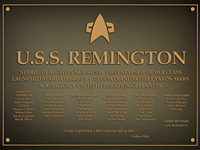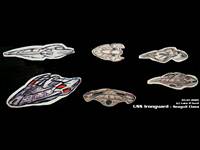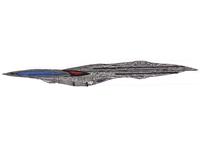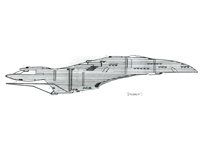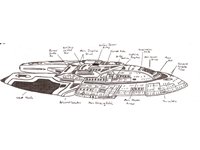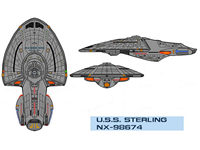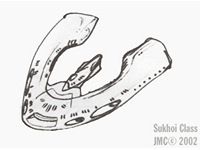Starships R-S
Starships, Starships A-B, C-E, F-H, I-L, M-N, O-Q, R-S, T-Z, Space Stations
Razorblade Class
Design by David
Type: Cruiser
First commissioned: 2379
Length: 570m
Width: 460m
Height: 112m
Decks: 23
Displacement: 4,700,250t
Complement: 90 officers + 700 crew
Speed: Warp 6.78 (cruise), Warp 9.97 (max.), Warp 9.98 (max. emergency)
Armament: Phasers: 2 dorsal saucer Type-XII arrays, 2 ventral saucer Type-XII arrays, 1 ventral stardrive Type-XII array; Torpedoes:1 fore Mark 98 Burst Fire Photon/Quantum Launcher, 1 aft Mark 98 Burst Fire Photon/Quantum Launcher
The Razorblade class starship was developed with both defensive and offensive mission profiles in mind. Hence it was equipped with ablative hull armour capable of withstanding continuous assault by or equivalent to 2 Galor class cruisers for extended periods of time. Also a large sliding plat of molecularly treated plasteel treated armour that retracts over portions of the secondary hull to protect the deflector dish and engineering sections during battle. The Torpedo launcher technology was designed to allow both photon and quantum torpedoes to be directed and fired from all of the ships launchers as needed. Dual mode launchers allow faster accessibility to both forms of torpedo and less decentralisation of launcher units to various parts of the ship, unnecessarily complicating firing patterns. The hull was produced more for functionality than for aesthetic value, the streamlined portions of the hull distributed to compensate larger, bulkier areas of the hull used to store many of the major system components such as the primary data cores and the warp drive assembly. The Warp drive nacelles are the Series 45 General Electric Advanced Linear Warp drive nacelles, utilising many of the newer subspace friendly upgrades developed over the last several years and installed on many ships from the Intrepid to Sovereign classes. The smaller chassis reflects the more miniaturised features available to the newer lines of warp engines such as the Nova and Intrepid classes.
The Razorblade class was nearing final production stages when news of the Enterprise-E's encounter with the super weapon starship, the Scimitar, reached Federation news agencies. The news was startling and prompted large schedule changes to all starship production facilities inside Federation space to accelerate tactical projects such as the Razorblade herself. Additionally news reached the Federation that rogue Jem'Hadar factions had formed after the peace talks with the Dominion over 4 years before, such elements had not been thought to extent further than small disloyal garrisons within the Gamma Quadrant outposts. But recently the factions had gained control of several facilities close to Founder space which was a cause for concern on both sides of the wormhole. The Razorblade class was launched in late 2379 and was assigned to many deep space assignments to replace key communications and sensor units and substations along Federation space and several in the Gamma Quadrant. Others were deployed with other deep space groups to patrol border and protectorate territories near the edge of known space. Unfortunately in early 2380 the USS Skoode was lost with all hands when she fell victim to a large spatial tear, a collapsing subspace rift, while on manoeuvres in the Gamma Quadrant, the rescue ship, USS Hood was unable to tractor her free before the tidal forces from the rift claimed the ship. The rift closed shortly after and repeated attempts from the Hood and Razorblade to find the ship were unsuccessful. The region was monitored for some three months after the incident but no sign was ever found of the cause or remains of the rift. The Chared and the Therner were also lost weeks later when they reported contact with seven unidentified starships and subsequently stopped transmitting. The Razorblade made several sensor sweeps of the region but reported nothing but microscopic debris fields and decayed warp trails leading away from the region, all attempts to pursue failed. Even when fitted with a highly advanced hybrid Romulan Federation cloaking device that allowed her to gain entrance to nearby territories undetected, her searches turned up unsuccessful.
Plans on sending the Razorblade class on longer and further voyages into unexplored regions of the galaxy and areas surrounding Federation space over the next several years once the first series of deep space assignments have been completed. Although Starfleet may defer those duties to the design groups newer design, the Bora class due for completion sometime before that.
Thanks To Chemahkuu for the write-up for the ship and weapon specs.
Remington Class
Design by Kevin
Type: Explorer
First commissioned: 2383
Length: 600m
Width: 200m
Height: 115m
Decks: 25
Displacement: 1,860,000t
Complement: 65 officers + 235 crew, evacuation limit: 700
Speed: Warp 9.2 (cruise), Warp 9.9 (max.), Warp 9.99 (max. emergency)
Sublight speed: 0.65c (max.)
Armament: 10 type-twelve phaser arrays, 6 quantum torpedo launchers, full Spectrum EM/quantum navigational deflector dish array
Defense: Regenerative shields, heavy duranium/tritanium double hull plating, ablative armor, metaphasic shielding, pinpoint shielding
Embarked craft: 4 personnel shuttlecraft; 2 shuttlepods; 2 special-purpose craft; 2 cargo shuttlecraft; 1 warp-capable captain's yacht; 144 emergency lifeboats, capacity of 5 per lifeboat; 2 flights of Federation Starfighter Corps Sisko-Class assault fighters, totaling 12 fighters; 2 Federation Marine troop dropships
Soon after the end of the long and bloody Dominion War, Starfleet began to realize that larger ships such as the Galaxy-Class were becoming harder and harder to come by. They needed a ship that was smaller but could still accomplish the same goals and mission parameters that a Galaxy-class could. Thus, just before the historic Romulan/Federation Peace Accords, the Advanced Starship Design Bureau submitted the blueprints for an official successor to the Galaxy-class. Construction of the all-new class began at Utopia Planitia Fleet Yards in 2380. Two years later, the Remington-Class was unveiled. On stardate 60087.5 Starfleet's newest explorer was launched and went about its shakedown cruise without a hitch. After the design was proven capable, the prototype, NX-86753, was given an official NCC prefix and several more Remington-Class vessels began construction.
What truly makes the Remington-Class unique is its adaptability to different mission profiles. Despite it being 17 decks smaller and 42 meters shorter than the Galaxy-class, the Remington is fully capable of carrying out the same scientific duties as the Galaxy. It is equipped with full scientific facilities and is fully adaptable to many different mission profiles. The design also includes many technological advances brought back from the Delta Quadrant by the crew of the USS Voyager, including a full Astrometrics laboratory. In addition, the ship carries an Emergency Medical Hologram with full upgrades comparative to those of Voyager's Doctor. These improvements, along with the ship's Chief Medical Officer, allow for two doctors at once and nearly double patient survival and recovery rates.
Tactical systems, as expected in the post-Dominion War era, are significantly lower. However, certain new systems make up for the lowered offensive capabilities, and the Remington is more than capable of defending itself if attacked. Primary armaments include 10 Type-XII phaser arrays and 4 quantum torpedo launchers. One phaser array is mounted on each nacelle pylon and on both sides of the secondary hull. Another phaser is mounted on the belly of the secondary hull. The dorsal primary hull carries three arrays; two are mounted aft and one fore. The final two phasers are mounted on the ventral primary hull. All four of the torpedo launchers are mounted on the secondary hull; two face directly aft, two to the fore. The Remington was also the first vessel to test out a revolutionary new shielding system called pinpoint shielding. The system involves a subspace field to be projected over the computer systems linked to the shields, allowing the sensors to work at faster-than-light speeds. When a threat is detected, such as torpedoes or phaser fire, the computer can calculate the general area of the impact upon the hull. The shield from other non-vulnerable parts of the ship is diverted to the area of impact, thus increasing the strength of the shield in that area to many times what an equal field projected over the entire ship could do.
Remington's propulsion systems are built around a quantum fusion warp core and matter/antimatter reactor assembly. The core feeds two fifteen-coil warp nacelles that can propel the ship to a maximum warp speed of 9.99 and are replenished by Bussard ramscoop collectors at the fore of each nacelle. Non-warp propulsion is provided by two impulse engines and four maneuvering thrusters in the saucer hull. Main Engineering contains the core/reactor assembly, along with several workstations for engineering staff. The Chief Engineer's officer is located off of Main Engineering and is comparable to most staff offices. Main Engineering also contains several new technologies, the most significant of which is the 3-dimensional master systems display "pool table" which allows for better observation of ship systems as opposed to the old 2-dimensional type.
Auxiliary craft include four personnel shuttles, two shuttlepods, two special-purpose craft, two large cargo craft, similar in design to the Argo carried on the USS Enterprise-E, and one captain's yacht. The yacht is capable of carrying up to six people in relative comfort, but can carry up to twice that much if necessitated. In addition, the Remington is one of the first to carry a complement of Federation Starfighter Corps pilots in addition to the new Sisko-class assault fighters. The Remington carries two flights of the fighters, which totals 12 fighters. In addition, two Federation Marine dropships, used for covert insertions of Marine teams, are standard aboard most vessels of the class. All craft embarked on the Remington, apart from the shuttlepods, are independently warp-capable, but at significantly lower speeds. The ship possesses two shuttlebays; the first is located on decks 4 and 5 with the second on decks 19 and 20. The latter is usually reserved for the fighters and dropships, but can be used for the other embarked craft if necessary. 144 lifeboats are also carried on the ship with a capacity of 5 each. Thus, the ship can safely evacuate a full crew and 420 other people safely.
Crew quarters follow a standard design. However, because crew is light on the Remington-Class, crewmembers can enjoy a few more amenities in their quarters. Junior enlisted crewmembers and junior officers still have to share a room with others of similar rank, but even the two-person rooms are relatively well equipped with a full bathroom and a small living area. Senior officers have slightly better accommodations and have rooms to themselves. They have both a larger bathroom and a larger living area. The captain's quarters are the most luxurious on the ship and are only equaled by VIP and ambassador quarters. All quarters are equipped with a viewscreen showing an outside view as opposed to a window. Senior crew offices are well equipped as well, but are located in specialized locations. For instance, the CMO's office is located within sickbay and the counselor's office is located close to crew quarters so crewmembers don't have to go far if a visit to the counselor is necessary. Because of the vast wealth of knowledge accumulated by The Doctor of USS Voyager during his stay in the Delta Quadrant, the Remington-Class' sickbay is among the most advanced in the fleet. As previously mentioned, Sickbay is staffed by both the CMO and an upgraded EMH. Overall, the CMO is considered superior, authority-wise, to the EMH, but the EMH shares just as much medical authority over the crew as the CMO. All techniques created by The Doctor are catalogued in Sickbay and almost any ailment known to Starfleet can be healed in a short time. Unlike The Doctor, Remington-class EMHs do not possess the still-being studied technology of the mobile emitter; thus, the EMH is restricted to holo emitter-equipped areas of the ship and cannot participate in away missions. However, like The Doctor, Remington-class EMH's are considered sentient and given free reign over what type of personality they wish to project.
Despite the limitations of such a small ship with a small crew, many Starfleet engineers are confident about the future of the fleet when the Remington-class is at the forefront. Along with ships like the brand new Luna-class, the Remington is part of a new generation of Starfleet vessels. With the Borg destroyed and the Dominion in a state of surrender, the galaxy is at peace once again. There's a lot of space in the galaxy that has yet to be explored. New ships like the Remington will be the first to search through the vast expanse and seek out new life and new civilizations.
Remington Design by Kevin, bridge design by Kevin and Harm von Rijbroek, dedication plaque by Kaden, MSD by Sean Larocque
Rigel Class
Design by Tim 'Suricata' Davies
Type: Cruiser
First commissioned: 2345
Length: 498m
Width: 267m
Height: 91m
Decks: 24
Complement: 60 officers + 390 crew, evacuation limit: 1400
Speed: Warp 9 (cruise), Warp 9.4 (max.), Warp 9.6 (max. emergency)
Sublight speed: 0.7c (max.)
Armament: 7 Type IX collimated phaser arrays, 2 Mk 70 Direct-Fire photon torpedo tubes
Defense: CIDSS-1 primary force field and deflector control system
Embarked craft: 4 Work Bee general utility craft, 6 shuttlecraft (various classes), 2 shuttlepods (various classes)
Mission profile
The Rigel class starship began is design life after Starfleet announced a new replacement was needed for the aging Excelsior class starships. The Rigel class was designed to endure short to medium term missions including border patrols, planetary defence and diplomatic courier duties.
Class history
It was hoped that the Rigel class would replace the Excelsior class. The class was designed with many advanced features from the then new Ambassador class vessels and Starfleet intended the Rigel class to support the Ambassadors as a backbone starship and workhorse of the fleet. Several vessels were completed and successfully entered service, however, shortly after production started, a relatively cheap refit program was announced for the Excelsior class starships, although the Rigel class was technologically superior to the refitted Excelsiors, Starfleet decided that the cost effectiveness was to high to build new ships when there were so many Excelsiors available for refit and thus production was stopped.
The Rigel class ships that did enter service performed admirably and were the most advanced ships in the fleet until classes like the New Orleans and Nebula classes entered service. However, since only a handful of these vessels were produced they are quite a rare ship to see. Most of the remaining Rigel class vessels now operate on border patrols within the Federation's core.
Scepter Class
Design by Unknown
First commissioned: 2374
Length: 495m
Speed: Warp 8.5 (cruise), Warp 9.2 (max. cruise), Warp 9.8 (max. for 6 hours)
Crew: 655
No description
Seagull Class
Design by Luke D'Anvil
Type: Multitask vessel
First commissioned: 2385
Length: 305m
Width: 170m
Height: 72m
Decks: 18
Displacement: 2400000t
Complement: 40 officers + 310 crew, evacuation limit: 600
Speed: Warp 9.7 (cruise), Warp 9.8 (max.), Warp 9.998 (max. emergency)
The USS Seagull and the USS Ironguard are two prototypes which are strongly influenced by an unknown alien warp technology. Engineers of the corps are still testing the adaptive devices, found on organic ship at a deep-space mission in the Delta Quadrant.
Sebring Class
Design by Jason, ASDB Member
3D model by Kenny, ASDB Member
Type: Destroyer
No description
Sentinel Class
Design by Bob Ginei
Type: Heavy cruiser
Length: 674m
Beam: 206m
Height: 126m
Decks: 25
Max. speed: Warp 9.9978
Crew: 510
Shuttlebays: 2
Shuttles: 27
The Sentinel class was developed as a replacement for the Sovereign class in the late 2380's. It incorporated the newest technology, like two deflector dishes, transphasic torpedoes, pulse phasers and advanced shields. This class has a captain's yacht docked behind the ventral torpedo launcher. The first ship of the class was the USS Sentinel NX-78906, the second was the USS Nelson NCC-78907 and the third the USS Hornet NCC-78908.
Settsu Class
Design by James Donovan, computer drawing by Malcolm Lu
Length: 480m
Beam: 188m
Height: 80m
Mass: 1,450,000mt
Decks: 24
Crew complement: 45 officers + 235 crew
The Settsu-class starship is a development of new technologies blended with existing Starfleet technology. The need arose to build these ships due to Starfleet losses from both the Borg and Dominion incursions into Federation space. The space frames were developed as smaller Sovereigns with about the same punch defensively, requiring only half of the crew of the Sovereigns. The starships put to use technologies uncovered by U.S.S. Voyager during her adventure in the Delta Quadrant. The ships have improved ablative armor and bio neural gelpacks. The shuttle craft are more offensive in nature than previous Starfleet craft. They are meant to be attack craft for the support of offense away from the main ship. The warp nacelle pylons sweep up from the bottom of the secondary hull instead of placed at the mid or upper points as on other vessel types. The vessel follows the design philosophy of the Belknap cruisers from the mid 23rd century. Other vessels of this type include the Susquehanna cruisers from the early 24th century. They are slightly larger than the work horse Excelsior class ships.
The first vessel entered service in 2375. The Agamemnon is the only vessel not in standard service due to being a testbed for slipstream drive systems, and has different deflectors and warp units. U.S.S. Agamemnon (NCC-90156) has a dual warp/slipstream drive propulsion system. As of 2380 tests show possibility of slipstream as a new means of Starfleet ship propulsion, replacing the warp drive systems now widely in use.
Shadow Class
Design by Kaden Dark
Type: Escort/cruiser
Length: 220m
Beam: 160m
Height: 40m
Speed: Warp 9.985 (max. sustainable)
Crew complement: 170
The development of the Shadow class began in 2378. The ship features ablative hull armour, regenerative shielding, quantum torpedoes and Type-XI phaser arrays. The warp coils are based on the Defiant-class design. The shuttle complement includes one squadron of Valkyrie-class fighters and three standard Type-9 shuttles.
Shark Class
Design by Voron
Type: Border cutter / light destroyer
First commissioned: 2384
Length: 280m
Width: 120m
Decks: 7
Complement: 80 officers + 20 crew, evacuation limit: 300
Speed: Warp 8.8 (cruise), Warp 9.6 (max.), Warp 9.8 (max. emergency)
Armament: 5 Type-10 phaser arrays; 4 Type-9 phaser arrays; 1 Type-IV torpedo turret (rapid fire); 2 Type-VI burst fire tubes (aft)
Defense: enhanced shields, ablative armour
Embarked craft: 3 Shuttle
The Shark-class light destroyer represents the cutting edge of the Starfleet light destroyer range designed to supplement older Sabre- class ships. The Shark class was designed from the keel up as a destroyer/border cutter. The Shark and her sisters where fitted with the latest offensive and defensive systems to enhance her combat capabilities. The Shark class is designed to operate in three formations for combat.
The first formation is in the "wolf pack". This comprises four Shark class sharing sensor data (or tied in to a larger sensor network) patrolling an assigned area providing back up for each other. This is used on the Romulan NZ when linked to the sensor net there. The second formation is in fleet engagements where the shark became a predator hunting down small to medium sized ships in defence of larger ships or in offensive actions with them. Once again the Shark will tie its self in to the larger ships sensors using them to enhance its own sensors. The third is system defence/ roving strike group. This is when the Shark is tasked to a battle group which is then assigned to defence or offence. Again the Shark will tie its self in to the larger ships' sensors using them to enhance its own. The sensors the Shark uses are a version of the Intrepid class long range sensors. They don't have the range of the Intrepid class sensors but they do have increased resolution. Despite its war like name the Shark can be used for other missions. Shark- class ships serve as high speed diplomatic transports/ courier ships. For this the design has guest quarters and conference rooms. Although these are more cramped than on most ships they are still more spacious than the Shark's other quarters. The other peaceful task is scientific missions where its enhanced defences can withstand in more hazardous environments. Also the enhanced resolution of the scanners can give detailed scans from inside a spatial body such as a nebula. The main reason for the Shark's existence is combat though.
The Shark is a very cramped ship due to its status as a destroyer of the fleet. Its warp core is based on the USS Defiant's but is extended from 4 decks high to six allowing a more controlled reaction of matter and antimatter to take place. The Shark can operate away from the Federation for one year and carries enough supplies for the crew for this time. A major overhaul is recommended every 15 years. So far the Shark and her three sisters (USS Stingray, USS Hammerhead, USS Manta Ray) have performed above the expectations of Starfleet. But it was decided that there was a need for the third production example was to be modified to increase its sensor performance and impulse drives to a higher standard. Production is now ongoing at five locations around the Federation with 12 in commission and four in shake down with a further 30 in various stages of construction. A contract has been signed for 46 of these destroyers by the end of 2385 and a further 100 being produced over the next three years.
Sonoma Class
Design by Brent Fulton
Type: Long-range explorer
First commissioned: 2384
Length: 230m
Width: 80m
Height: 40m
Decks: 13
Complement: 80 officers + 220 crew, evacuation limit: 250
Speed: Warp 9.5 (cruise), Warp 9.9 (max.), Warp 9.99 (max. emergency)
Armament: 6 phaser emitters, 4 torpedo launchers, 2 turrets
Defense: ablative armour, shield emitters
Embarked craft: 4 shuttles and 1 captain's yacht
Designed as a deep space exploration vessel, warp nacelles tuck behind saucer section when in slipstream to reduce stress from slipstream wake. Lightly armed, but heavily fortified with ablative armour. Designed following U.S.S. Voyager's return from Delta Quadrant, specifically to use the new technology brought back by Voyager.
Thanx to the writers of Voyager and all Star Trek sources who've helped me steer this design to what it is today.
Sparrow Class 
Design by Benjamin Wilcox
Type: Explorer
First commissioned: 2385
Length: 160m
Complement: 15 officers + 65 crew, evacuation limit: 400
Speed: Warp 8 (cruise), Warp 9 (max.)
Armament: 7 Type VIII Phaser Arrays, 2 Forward Torpedo tubes
Defense: Regenerative shields, Ablative hull armor
Embarked craft: 3 Shuttle craft
In the late 24th century, advances in Warp field theory, and subspace dynamics gave rise to a new form of Starship warp drive using an articulated warp coil assembly. These advances led to the creation of the Sparrow class starship. The sparrow class is designed to provide deep space exploration capiblities is a smaller space frame, with a smaller crew. The design has features similiar to the deiant class and nova class starships, with a few exceptions. The shuttle bay is in the forward hull 2 decks down from the bridge. This was done to facilitate the articulated warp coil assembly.
Sparrowhawk Class
Design by Paul Lloyd, original nacelle design by Masao
Sparrowhawk-class scout ship USS Chickenhawk NCC-63081
Type: Scoutship
Development beginning: 2364
Length: 160m
Beam: 62m
Height: 33m
Max sustainable speed: Warp 9.55
Crew complement: 25 (including mission specialists)
No description
Spartan Class (2)
Design by Kyle Thomas
Type: Cruiser
First commissioned: 2379
Length: 324m
Width: 156m
Height: 56m
Decks: 14
Displacement: 807000t
Complement: 40 officers + 125 crew, evacuation limit: 2600
Speed: Warp 6.5 (cruise), Warp 9.55 (max.), Warp 9.9945 (max. emergency)
Sublight speed: 0.97c (max.)
Armament: 8 Mark XII phaser arrays, 2 Mark I point defense phaser arrays, 8 torpedo tubes
Defense: Modulating shield array, duratanium-tritanium hull plating
Embarked craft: 3 Mark 7 Valkyrie class fighters, 1 Leonadis class captain's yacht, 5 type 11 shuttles, 1 Argo class transport
Objectives
Pursuant to Starfleet Exploration Directives 1015.9 & 1020.16, Starfleet Defense Directives 200.0, 197.5 & 197.6, and Federation Security Council General Policy, the following objectives have been established for a Spartan Class starship:
- Provide autonomous capability for full execution of Federation defensive, cultural, scientific, and explorative policy in deep space or border territory.
- Complement Starfleet's forces after the Dominion War.
- Provide a platform for extended scientific survey and scouting missions.
- Serve as a frontline support vehicle during emergencies and a platform for the extension of Federation diplomacy and policy.
- Provide non-critical functions such as transport of personnel and cargo when necessary, extended aid, and short-range patrol.
General overview
Hosting a few minor upgrades available after the Dominion War, such as dedicated Marine facilities, point defense phaser arrays, bio-neural gel packs with Borg inspired upgrades, dual warp cores, and extending warp nacelles similar to those found on the 'Delta Flyer' runabout. A revolutionary design, which bypasses the need for a star-drive section, due to two separate warp cores, joined to a main core at the center. The dual warp cores run the length of each nacelle. With the success of the wing like nacelles of the Intrepid and the new idea of the extending nacelles from the Delta Flyer, Starfleet put the idea into test and integrated it into the Spartan Class. The Spartan class has several other abilities such as the ability to make planet fall, an ability it shares with its Intrepid Class cousin, it also can be configured to play many different roles, such as Medical Aid Post, Courier, VIP Transport, Exploration Cruiser of Deep Space Vessel. The class will have a distinguished career in Starfleet and plans have been put forward for 12 additional ships to be built in the next 3 years.
Thanks to Epsilon Force (RPG Fleet) and the people at SCN Forums.
Springer Class
Design by Robert Heckadon
Type: Medium explorer
Length: 374.81m
Width: 202.89m
Height: 43.74m
Complement: 175 officers and crew
Armament: 7 type X phasers, 4 photon/quantum torpedo launchers
Speed: Warp 9.98 for 12 hours
No description
Springer 2 Class
Design by Robert Heckadon
Type: Medium explorer
Length: 329m
Width: 200m
Height: 44m
Deck count: 14
Complement: 175 officers and crew
Armament: 10 Type-XII phasers (std.), 2 pulse phaser cannons (optional), 4 torpedo launchers (std.), std. complement of 224 photon torpedoes and 32 quantum torpedoes
Speed: Warp 8 (std. cruise), Warp 9.6 (max cruise), Warp 9.995 (max. emergency)
The Springer-2-class starship is an immediate upgrade or total redesign of the original Springer-class starship. The redesigns have included the removal of the 6 replacement pods on the saucer for improved structural integrity, and replaced them with 6 highly efficient solar collectors. But to retain some of the original ships multipurpose features, each nacelle has an upper attachment port for small pieces of equipment including communication arrays, high power sensors, and weapons. For general missions, the ports normally have an attached phaser array. With talks between the Federation and the Sheliak breaking down in the late 2380's, most Springer 2 class are now carrying high power pulse cannons on top of the nacelles in a similar fashion to the Defiant-class starship.
Starburst Class
Design by Lars
Type: Scout
Note the coincidental similarity to Jason's Sequoia!
Starshield Class
Design by T. Junk
No specs available
No description
Starwolf Class
Design by Weyoun
Commissioned: 18th October 2380
Length: 421m
Height: 80m
Width: 298m
Decks: 20
Crew complement: 412 officers and crew
Evacuation capacity: 1,000
Impulse speed: 0.20c (cruise), 0.25c (max.), 0.253c (upper limit)
Warp speed: Warp 7 (cruise), Warp 8.2 (max. cruise), Warp 9.9 (max. warp), Warp 9.9967 (max. slipstream)
Acceleration: rest-onset critical momentum: 5s, onset critical momentum - warp engage: 2s, Warp 1-Warp 4: 0.871s, Warp 4-Warp 6: 0.737s, Warp 6-Warp 9: 1.002s
Duration: 10 years (std. mission), recommended yard overhaul: 20 years
Warp propulsion: 4 LF-50 Advanced Linear Warp Drive Nacelles
Impulse propulsion: 2 FIG-8 Subatomic Unified Energy Impulse Engines
Other propulsion: RCS thruster array
Warp core: 1 Type 12-X core (modified for slipstream)
Weapons: 6 Type-12 Collimated Phaser Arrays (9 with tactical pod), 4 Mark- 95 rapid-fire torpedo launchers (10 with tactical pod), 100 photon torpedoes, 77 quantum torpedoes
Defense: regenerative shielding, 3cm ablative armor, metaphasic shielding
Primary navigation system: RAV/ISHAK Mod 3 Warp Celestial Guidance
Primary computer system: M16 Bioneural Isolinear Optical Data Network
Deflector systems: F-SS4 Regenerative Primary Force Field and Deflector Control System
Embarked craft (typical): 12 shuttlecraft: 2 Type 9, 3 Type 6, 3 Argo Type, 4 Type 16, 5 shuttlepods: (5) Type 15, 8 work bees: 8 "Wally" class
Starfleet engineers saw an increasing need for multipurpose starships like the Nebula class, but ships also capable of defending Federation space. From this need came the Starwolf, a ship with the versatility of a Nebula class with exchangeable pods but the durability of an Akira. The U.S.S. Starwolf NX-79129 was launched in 2380 under the command of Captain Jake Edwards. Though the ship was designed to help explore the galaxy it was assigned to defend Federation borders near Breen space. After a year of patrol the Starwolf was chosen to be equipped with the new slipstream technology, and since has proven the worth of slipstream. The Starwolf is currently assigned to exploration of the Gamma Quadrant.
Steadfast Class
Design by Luke D'Anvil
Type: Heavy escort vessel
First commissioned: 2386
Length: 220m
Width: 280m
Height: 64m
Decks: 16
Displacement: 2,100,000t
Complement: 20 officers + 130 crew
Speed: Warp 9.1 (cruise), Warp 9.3 (max.), Warp 9.55 (max. emergency)
During the Dominion War the Fleet Command saw the necessity of a ship made for battles to the bitter end. The Steadfast class is the answer of a team of engineers to that request - the machine section is build for one last effort: An automatic suicide run. There are skeptics at Fleet Command who still don't want this ship class to be built. The critics were confirmed in their fears, when the prototype was stolen from the dock under mysterious circumstances. A first commission of inquiry assumes Section 31 behind this perfidious plan.
Sterling Class
Design by Dominik
Type: Long-range research vessel
First commissioned: 2413
Length: 221.97m
Width: 138.34m
Height: 51.45m
Decks: 14
Complement: 162
Speed: Warp 6 (cruise), Warp 9.3 (max.), Warp 9.853 (max. emergency)
No description
In friendly cooperation with T. Junk, I revisited his Sterling Class starship as a vector graphic with Inkscape. Had the possibility to correct the measurements and add several new details and every view angle.
Sukhoi Class
Design by Jason, ASDB Member
No specs available
The Sukhoi class may be a shared development by the Federation and the Son'a.





